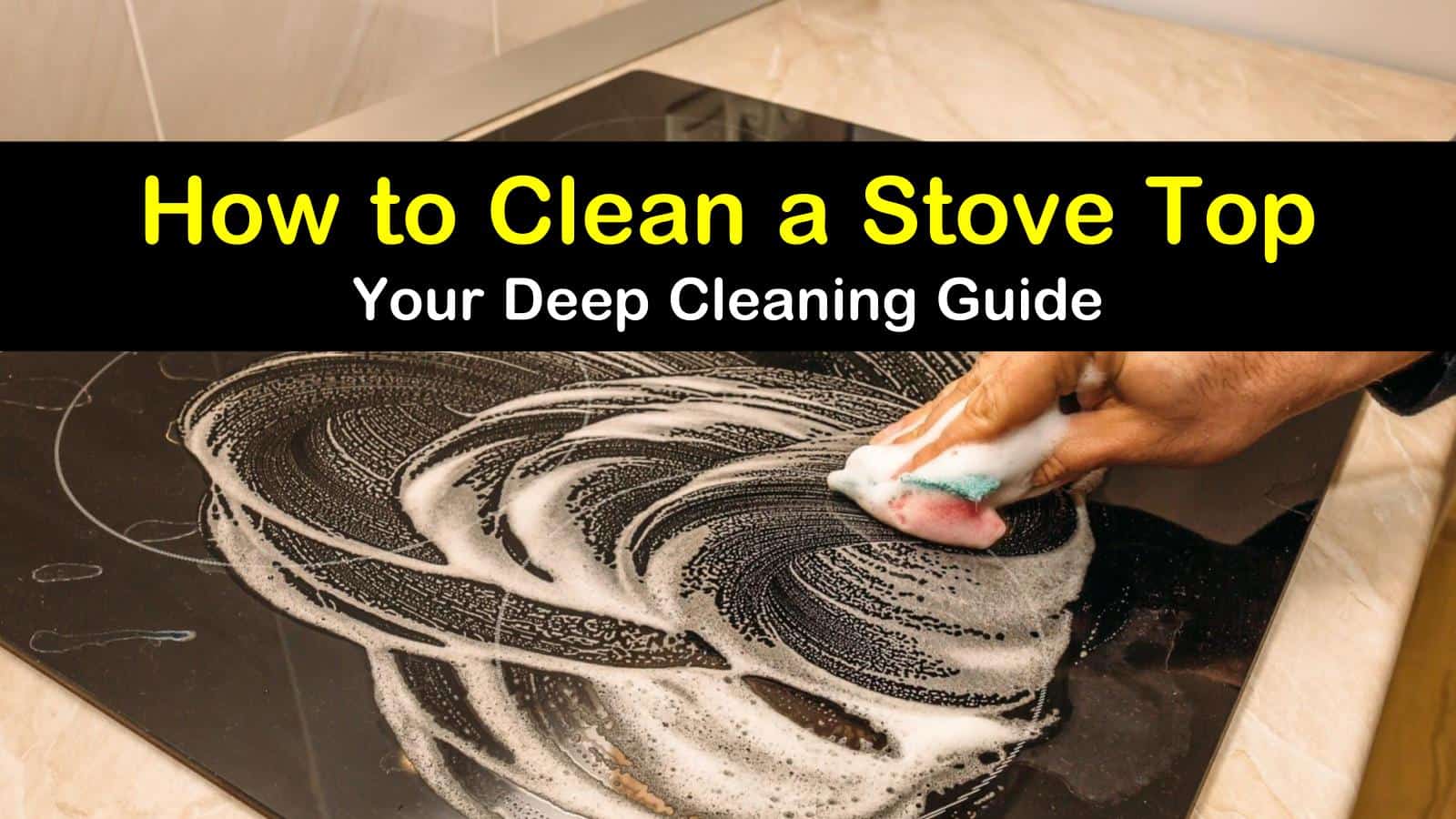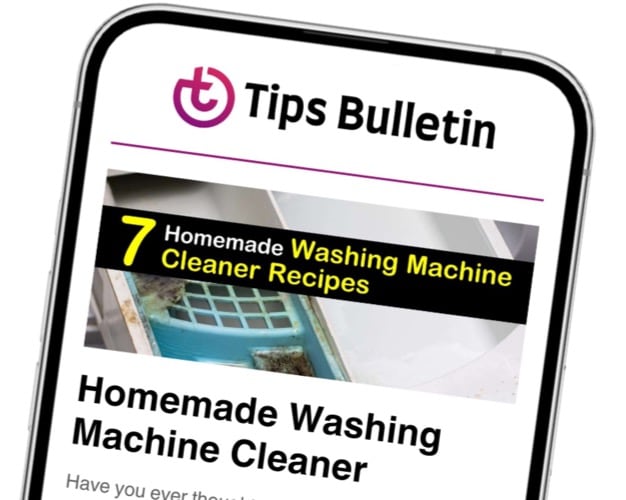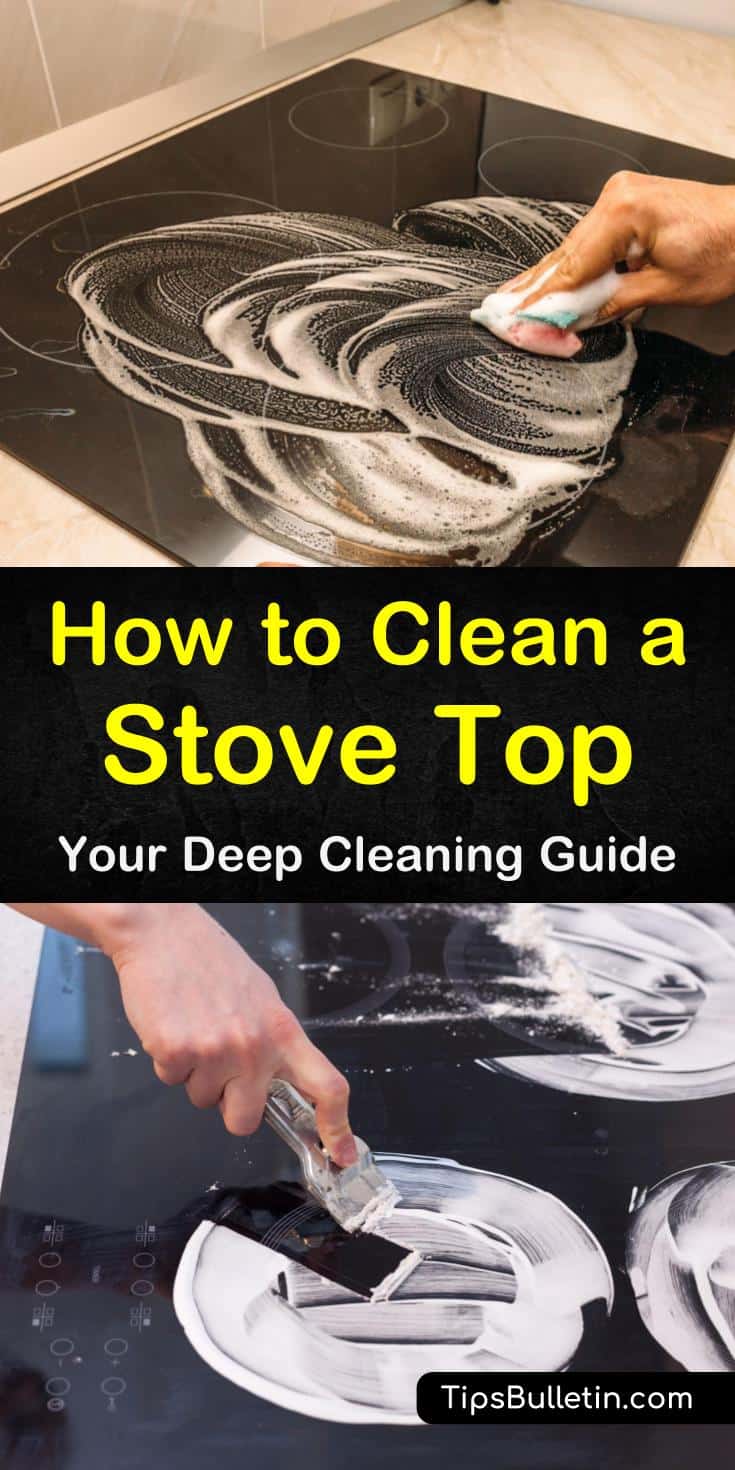No matter how poised and polished of a chef you are in the kitchen, mistakes can happen, and stove tops can get messy fast! You might walk away from a gradually heating pot of pasta sauce for two seconds, get easily distracted by other chores or family members, and return to a Vesuvius-style mess of epic proportions.
You need to know how to clean a stove top quickly, without damaging your model of stove or transmitting harsh chemicals into your food. Doing this is often a simple solution that requires no more than reasonable, old-fashioned elbow grease and some spectacular DIY cleaning recipes.
Those little splatters are a thing of the past when you combine abrasive cleaners to scrape away burnt-on foods with degreasers that effortlessly wipe away any oily residues. Most of the recipes you’ll encounter include ingredients you use in your everyday cleaning routines, while ingredients like Citrus Fresh essential oil may send you on a well-worth-it trip to the store.

Many of these recipes are interchangeable and apply to most of the types of stove tops we will discuss throughout the article. However, your particular stove top may require additional cleaning techniques to cleanse the surface thoroughly.
- What are the different kinds of stove tops, and how do they differ?
- What are some safety precautions I should keep in mind when learning how to clean a stove top?
- Use Non-Toxic Ingredients for a Safe, Deep Stove Cleaning
- Clean Glass Surfaces Using a Vinegar Spray and Razor Scraper
- Heavy Cleaning of Induction Stove Tops to Remove Oily Residues
What are the different kinds of stove tops, and how do they differ?
There are four main types of stove tops: glass-top stoves, the gas stove, electric stove tops, and induction tops. Gas stoves use burner grates that hover over an open flame. While some homeowners find the gas stove an intimidating kitchen appliance, many chefs prefer the gas stove since the varying heat levels are easier to control using visual cues from the increased or lowered flames.
Electric stoves are the most common type of stove tops. The remaining three stove tops are technically electric stoves but can be broken down into individual groups based on their unique characteristics.
The classic electric stove uses heated coils that form spirals above metal drip pans and plug into an electrical outlet beneath the surface. The electric spirals are often challenging to clean, but most parts of this electric stove stop are easy to replace if damaged.
While commonly referred to as a glass stove top, this appliance is yet another accessible version of the electric stove. An electric current runs beneath the ceramic glass top and heats the pots and pans on the stove. The most significant advantage of a glass cooktop is that it is easy to clean, even if these types of stoves may take longer to heat.
The final type of stove top is slightly less common and is known as an induction cooktop. An electromagnetic field is how the induction stove top operates, transmitting a source of energy to the pan that heats your food. Induction stoves boil water faster than other electric or gas cooktops. The drawback, however, is that these types of stoves don’t always work for every pot or pan.

What are some safety precautions I should keep in mind when learning how to clean a stove top?
First and foremost, let the stove, and the oven, cool down before you begin cleaning. For gas stoves, do not allow any cleaning chemicals get on the igniters to prevent fires. If your gas stove still uses a pilot light, make sure this remains lit throughout the cleaning.
Using harsh chemicals to clean your appliances runs the risk of contaminating your food with the same chemicals, and in some cases hover in the surrounding air in unhealthy amounts. Instead of using harmful chemicals, use the natural, non-toxic solutions provided.
How to Clean Gas Stove Top Using Natural Cleaners
The most challenging part of cleaning a gas stove, or even electric stoves with coils, is all the small pieces you have to take apart and individually polish to ensure you get grease stains and stuck-on food off of everything. Routine cleaning of gas stoves is simple but can be time-consuming if the surface has a lot of grime.
Clean stove burners by wiping them down with a soft cloth dampened by a few drops of vinegar. On those occasions when necessity demands a deep clean of your gas stove, taking it apart is the only way to go.
Use Non-Toxic Ingredients for a Safe, Deep Stove Cleaning
It’s important to do things the right way when you start cleaning your stove so that you don’t have to go over the same areas again and waste time that you could spend doing something else.
Begin your deep cleaning by carefully removing the burner grates and caps from the stove top so that you can easily access the dirty area beneath them. Submerge the caps and gas stove grates in the sink filled with hot water and dish soap.
Allow these parts to soak in the sudsy water in the sink while you clean the burners on the stove. Use the following supplies to make a DIY stove top cleaner to clean your glass cooktop that will cut grease and make the grime easy to remove with a simple swipe of a clean rag.
When cleaning the burners, it’s essential to clear away loose debris or caked on foods first. Use a soft toothbrush or a paper towel to remove dried on particles before you start wiping. For sticky residue, grime, and burnt-on foods, use a mixture of lemon juice and white vinegar.
The two acidic ingredients form a natural degreaser that is perfect for removing grime and tough food stains from your burners. This tag team of acetic and citric acid is also an effective oven cleaner recipe, which means it will clean your appliance inside and out.
Clean the surface of the stove, around the burners, and inside the knobs with the cleaning solution until all visible spots and debris vanish. Wipe away the remaining cleaning solution with a dry cloth or paper towel. Try not to leave behind any grime, food particles, or moisture.
Your next step is to retrieve the burner grates and caps from the sink and use the same treatment on them. Wipe them down with the natural degreaser, rinse them clean, and then ensure that they are perfectly dry before returning them to the stove. Once your deep cleaning is complete, securely reattach all loose parts back onto the stove.
Cleaning an Electric Cooktop with Essential Oils
When thinking about how to clean a stovetop, you already know it will not always be as easy as wiping down a countertop. Routine cleaning of most electric stove tops truly is this simple and requires little more than a gentle clean with soapy water and a dry towel.
However, when it comes to more rigorous scrubbing, cleaning an electric coil stove can be as invasive as how to clean a glass stove top. The solution below will make cleaning individual parts a little easier and put you well on your way to a squeaky-clean stove.
Much like a gas stove, electrical components of an electric stove top also need to be carefully removed. Start by unplugging the coils and removing them from the burners. They should slide out easily along with the drip pans.
Drip pans should be soaked in a basin with dish soap and warm water while cleaning the coils. To use the antifungal stove top cleaner, combine the baking soda, water, and several drops of Citrus Fresh essential oil in a small dish. This mixture should form a paste that’s great for clearing away greasy residue and food particles.
The baking soda is an abrasive element that is still gentle enough to not damage the metals on your stove top. Citrus Fresh oil, on the other hand, is an antifungal and antibacterial that uses natural elements to combat grease. Together these make a phenomenal cleaning solution that can be applied to the coils, as well as the drip pans, using a soft scrubber.
After you have finished cleaning each removable part of the burners and the surface of the stove, rinse off the solution with clean water and dry to prevent water spots. Do not reattach the coils to the electrical receptacle in the stove until all parts are completely dried.
How to Clean a Glass Stove Top with a Brilliant Shine
While glass stoves are still technically electric, they are significantly easier to clean than their coiled counterparts. There are no tiny crevices for crumbs to hide under or detachable parts to deconstruct. Instead, taking care of a glass stove is as easy as a quick wipe down with a damp cloth and a few sprinkles of baking soda.
Clean Glass Surfaces Using a Vinegar Spray and Razor Scraper
So glass tops make stove cleaning easier, but that does not mean you will never encounter a sticky situation. Even the sleek finish of a ceramic glass stovetop can form caked on layers of gunk and food. In those cases, use the supplies below to leave a streak-free shine on your glass stove.
Add an equal quantity of white vinegar and hot water to an 8-ounce spray bottle. Shake the contents well and spray a generous amount across the surface of the stove. Hot water breaks down kitchen grime easily while vinegar is useful when removing hard water spots or stains.
White vinegar is also an excellent cleaner for stainless steel appliances, which polishes well when paired with a microfiber cloth. If the solution does not break down stuck-on food particles, use a razor blade to remove them. This kind of scraper usually comes with your stove top purchase.
If not, then refer to the manufacturer’s booklet to see what styles and brands they recommend. Chip away at burnt-on foods using this razor as gently as possible.
Be careful not to scratch the glass. Once you finish, wipe away all remaining moisture and grease using a clean microfiber cloth. Doing this will leave an impressive shine on your freshly-cleaned stove top.
How to Clean a Stove Top that Uses Induction Tops
Induction stove tops are exceptionally energy-efficient and are as easy to clean up as a glass stove top. Its smooth, flat surface requires no more than a damp sponge and a dab of mild soap to wipe it down during regular cleanings.
Doing this after every use is the best way to reduce food build up on the stove. Remember to wring out your sponge thoroughly before using it though, as this may cause an increase in water spots and stains.
Heavy Cleaning of Induction Stove Tops to Remove Oily Residues
Just like the glass stove tops, vinegar is an excellent cleaning solution. However, not everyone may have vinegar on hand. An excellent substitution for vinegar is to use moderate amounts of hydrogen peroxide combined with other active cleaning ingredients.
Instead of adding these ingredients into one large bowl and mixing them, add a few drops of dish soap to your cooktop along with a generous sprinkling of baking soda. Directly apply the two tablespoons of hydrogen peroxide onto the stove top, then scrub the moisture with a soft scrub brush or some paper towels.
Do not use abrasive sponges like steel wool, as these leave small scratches across your cooktop. Rinse the cleaning solution using a damp towel and dry it with a microfiber cloth. Just like glass tops, lint-free cloth like microfiber fabric buffs the surface of the stove into a streak-free shine.
Your stove is a gateway to delicious foods and mouth-watering flavors. So keeping it clean, and what you use to clean it, is as important as what goes into your tummy. These cleaning tips address all the best ways to clean your particular stove. They also use safe, natural recipes that won’t wreak havoc on your health or your wallet.

Hopefully, these recipes and methods for cleaning your stove have been an enjoyable and informative read. Hopefully, this article has given you the help you need to put back some shine in your burners. Pass on these helpful tidbits for how to clean a stove top to your friends and family by sharing on Pinterest and Facebook.